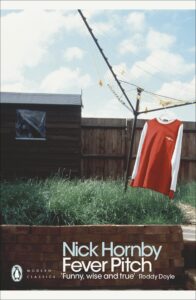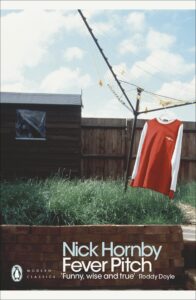 With the end of the 1991/92 season, the format of football in England shifted seismically; Leeds United were the last Football League Division One Champions and in 1992/93 the FA Premier League was born, to change forever the soccer landscape in this country. 1992 also saw the release of Fever Pitch by Nick Hornby, which transformed the way football literature was viewed to become a seminal work in sports writing.
With the end of the 1991/92 season, the format of football in England shifted seismically; Leeds United were the last Football League Division One Champions and in 1992/93 the FA Premier League was born, to change forever the soccer landscape in this country. 1992 also saw the release of Fever Pitch by Nick Hornby, which transformed the way football literature was viewed to become a seminal work in sports writing.
The book in structure is divided into three section, 1968 – 1975, 1976 – 1986 and 1986 – 1992, with a brief Introduction. Within each section, Hornby highlights certain fixtures to detail the relationship between his life and what he sees as the intrinsic links with football, rather than a ‘match-report’ format. Hornby is clear in the introduction to the book as to his reasons for writing Fever Pitch, detailing that it “…is an attempt to gain some kind of angle on my obsession…also, in part, an exploration of some of the meanings that football seems to contain for many of us…about being a fan…”
When first reading this book twenty years ago, it was a revelation to read something that I could relate to in terms of the passion, fanaticism and obsession with ‘my’ team. Hornby had captured the enthusiasm of going to your first game and how it hooks you in, continuing the story through adolescence to adulthood and the ‘highs and lows’ that occurred both in supporting your team and the angst associated with growing-up. The book had a ‘current’ feel to it as it was written and published with a backdrop in which the English game was still recovering and coming to terms with the fallout from the (then) recent events of Heysel, the Bradford City fire and Hillsborough.
Reading Fever Pitch again at the end of the 2012/13 season, Hornby’s Arsenal find themselves at the Emirates Stadium in a league that is a global brand, with a team where English players are in the minority and the days of epic FA Cup ties requiring numerous replays, are a thing of the past. This change in the football landscape over the last twenty years perhaps explains why for me reading the book second-time around, the focus fell more upon Hornby’s emotional journey through depression and his personal story than the footballing context. That said, Fever Pitch is still a hugely influential read in football literature, but given the shift that has occurred in the English game and its implications for clubs and all those involved in the sport, including fans, the time is surely ripe for a second football offering from the author. Unfortunately, it is unlikely to be a Fever Pitch 2 as Hornby has said that the success of the original altered forever his relationship with the club, in that he could no longer write from the perspective of the fan. Therefore, Fever Pitch should be appreciated for the classic it is and will continue to be in the future.
 For many people watching football is mere entertainment, to some it’s more like a ritual; but to others, its highs and lows provide a narrative to life itself.
For many people watching football is mere entertainment, to some it’s more like a ritual; but to others, its highs and lows provide a narrative to life itself. With the end of the 1991/92 season, the format of football in England shifted seismically; Leeds United were the last Football League Division One Champions and in 1992/93 the FA Premier League was born, to change forever the soccer landscape in this country. 1992 also saw the release of Fever Pitch by Nick Hornby, which transformed the way football literature was viewed to become a seminal work in sports writing.
With the end of the 1991/92 season, the format of football in England shifted seismically; Leeds United were the last Football League Division One Champions and in 1992/93 the FA Premier League was born, to change forever the soccer landscape in this country. 1992 also saw the release of Fever Pitch by Nick Hornby, which transformed the way football literature was viewed to become a seminal work in sports writing.